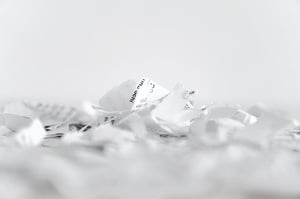Is there one among your friends who irritates you sometimes? They could be childhood buddies or a...
6 Tips To Go Paperless Today!
Are you tired of constantly searching through stacks of papers for important documents or feeling overwhelmed by the clutter in your home? If so, you're not alone. With the prevalence of bills, mail, magazines, and statements, it's easy for paper to accumulate quickly, creating chaos and stress in your daily life. Fortunately, there's a solution: going paperless. Not only can this save you time and improve convenience, but it can also reduce clutter and help you lead a more sustainable lifestyle.
However, for those accustomed to traditional methods of organization, making the switch can be daunting. But don't worry, we're here to help. In the following article, we've compiled a list of useful tips to assist you in your quest to go paperless. So, whether you're just starting out on your journey to reduce paper usage or looking to enhance your current paperless approach, these tips are sure to help you achieve your goals and lead a more sustainable, organized, and stress-free life.
Go Paper-Free!
-
Choose a Device that Works for You
 To get the most out of going paperless, finding a device that fits your needs is key. A cell phone or a tablet can be portable and allow you to eliminate much of the paper from your life. A tablet will be larger and have many of the same functions as a cell phone but will offer a larger reading surface and be easier to hold than a smaller phone.
To get the most out of going paperless, finding a device that fits your needs is key. A cell phone or a tablet can be portable and allow you to eliminate much of the paper from your life. A tablet will be larger and have many of the same functions as a cell phone but will offer a larger reading surface and be easier to hold than a smaller phone.Ensure that your device can connect to the Wi-Fi for access to emails and records, online banking, and any other needs that you have. There are many applications available that will allow you to read or listen to books, connect to your library, and make video calls.
-
Change Bills to Online Payment
Almost all utility and other service providers offer paperless billing. Log into your online account using the account number on your bills and select email billing. This will change all of your bills from regular mail to email. For the best organization and ease of use, create a new email account strictly for household bills. By having a separate email address, you will easily see each bill as it comes in and record when they are due and when you pay them.
Online billing works well in conjunction with online banking and bill payments, allowing you to open and review your bill and pay it without ever touching a piece of paper.
-
Bank Online
Are you still going to the bank in person and receiving statements in the mail? Online banking has become a popular way to do day-to-day banking tasks. By signing up with your current bank for their online banking service, you can save time and have complete control over your money. Most of your everyday banking tasks can be done on your bank's website, and for those who use apps on their phones or tablets, you can do even more.
With your online banking account, you can track your balance, pay your bills, and transfer money between accounts. It is easy to set up direct transfers from one account to the other, send money to friends or family, and more. You can also receive money from others through the e-transfer system and deposit it directly into your account.
Using your bank's application allows you to check your balance from anywhere, anytime! You don't have to wait for your next statement to come in the mail to see the balance of each account.
Many banks also offer the ability to deposit a check through the app, leaving only cash deposits or withdrawals requiring you to go to the bank or the ATM. Some banking apps will also allow you to use your cell phone to pay at restaurants and some stores through the interact tap system. Simply set up your banking for touchless payments, and when you are ready to pay, open the app and tap your phone on the debit machine.
-
Digital Planners and Calendars
While using a day planner can be key to staying organized and tracking appointments, bill payment dates, birthdays for friends and family, and more, they can be awkward to carry on the go. By downloading a note-taking app or program to your tablet or another device, you will be able to use digital planners. There are hundreds of digital planners and systems available, and most are easy to use and intuitive. They work just as a paper planner would, with a swiping function to turn the pages and the ability to add notes, write on the pages, and save for later. Once you have begun using your digital planner, it is easy to maintain and can be done year after year.
If you prefer a calendar that offers reminders, there is a calendar on most devices, and others are available for download. You can set reminders for activities or dates that repeat themselves, such as weekly classes, birthday reminders, anniversaries, and even task reminders. Set a reminder to book your annual check-up, follow-up appointments with doctors or specialists, when to have your car serviced, and more. Your device will alert you before an appointment as a reminder to complete the task or go to the scheduled event.
-
Scan and Recycle Records and Statements
 To reduce clutter and piles of paper, scan important documents into your computer, tablet, or phone and file necessary items while disposing of the remainder. Then, you can easily find old documents on your computer or tablet without having to dig through piles of paper, and you know they are safely stored digitally! These days, it's easy to scan documents with many at-home printers or even using mobile apps on your phone!
To reduce clutter and piles of paper, scan important documents into your computer, tablet, or phone and file necessary items while disposing of the remainder. Then, you can easily find old documents on your computer or tablet without having to dig through piles of paper, and you know they are safely stored digitally! These days, it's easy to scan documents with many at-home printers or even using mobile apps on your phone! -
Libraries and Bookstores
E-books allow you to read without printed paper books. Reading on a tablet or an e-reader allows you to adjust the text size to fit your needs, and the font can often even be changed. These can be accessed directly on your device and can be downloaded immediately. In addition, library books will be returned on their due date automatically, avoiding late fees.
Let us know in the comments below - what is your favorite reason to go paperless?



.jpg?width=600&name=7%20Signs%20of%20a%20Toxic%20Friendship%20(And%20What%20to%20Do).jpg)


